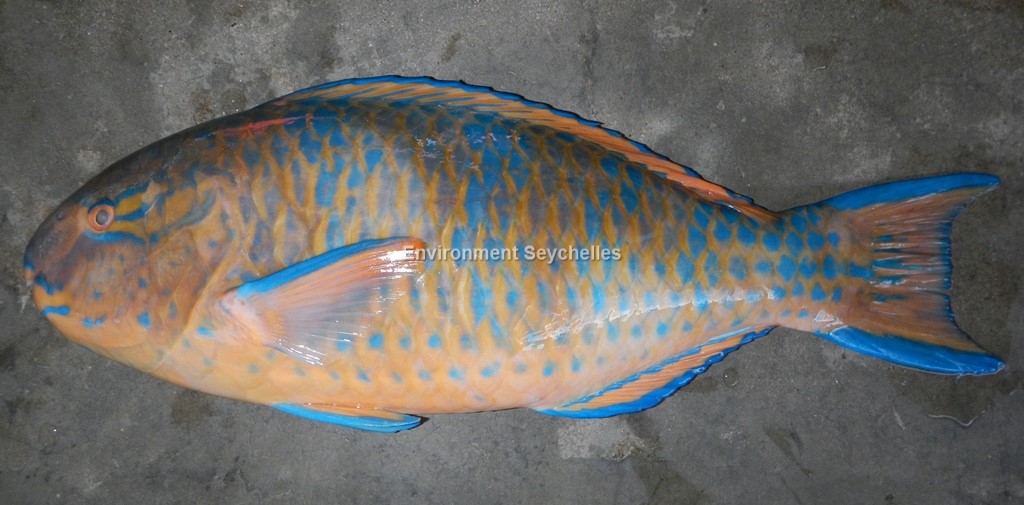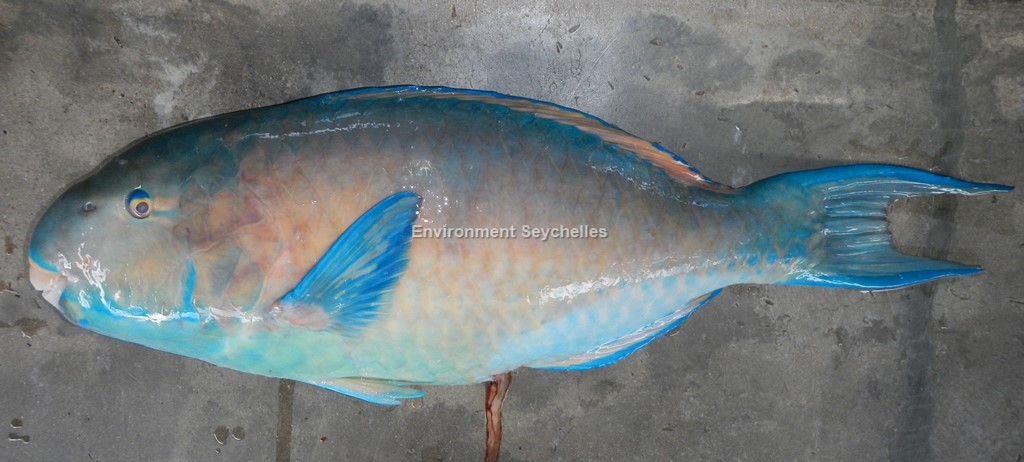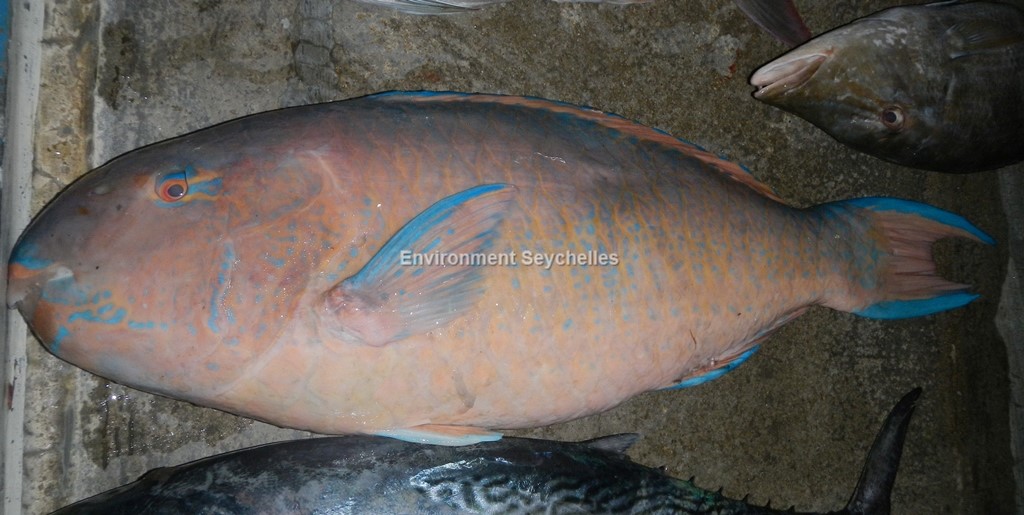Description:
Dorsal spines: 9; Dorsal rays: 10; Anal spines: 3; Anal rays: 9.
Medium to large sized parrotfish, moderately full-bodied. Lips cover more than half of dental plates, which are white in colour. 1 to 3 conical teeth
posteriorly on side of upper jaw of males. Rear nostril oval, 2 to 5 times larger than front nostril. Caudal fin emarginate to lunate.
Initial phase: dull orange-yellow when small to cream yellow when larger. Body scale yellow to cream with a blue spot, often giving mottled appearance.
Five irregular bars on the flanks are often formed by the enlarging of the blue spots within the bars. Head yellowish to orange; interorbital and dorsal
part of snout sometimes grey, lips salmon pink; a blue band across base of upper lip and a similar curved band on chin. A blue band from corner of mouth
a short distance diagonally downward and curving upward to below orbit. Three blue bands extend posteriorly from the eye. The dorsal and anal fins are
yellow with blue margins. Pectoral fins with light yellow rays and pale membranes, the upper edge blue. Pelvic fins yellowish white, sometimes with a
blue lateral edge. The caudal fin is orange yellow with broad blue upper and lower edges sometimes with blue streaks or spots on central part of fin and
emarginate.
Terminal phase: There appears to be considerable variation in colour of the terminal phase of S. ghobban in Seychelles.
Dorsal part of head and body green-blue the scales very narrowly edged in salmon pink to orange. Flanks yellow grading to green ventrally but this is not
always the case, pectoral fins blue. Iris yellow. Blue bands extending backwards from the eye. Scales of operculum in cheek orangish, sometimes suffused
with green. Ventral part of head varies from pale salmon pink though to pale blue green. Margin of upper lip bright salmon pink with a bright green band
above it. A broad irregular band of bright green from corner of mouth extending across lower cheek. Dental plates pale yellow-pink becoming whitish at
edges. The dorsal and anal fins are yellow with a blue margin and a band of blue green basally. In spinous portion of dorsal fin, spines may be blue
basally up ¾ length. Pectoral fins largely blue green with a broad partially broken streak of orange to salmon pink extending from mid base to tip of the
longest rays. Pelvic fins pale yellow with a blue lateral margin. Caudal fin lunate pale blue-green with blue lobes.
Size:
Maturity: Lm unknown. Range: 49 - ? cm. Max Length: 75 cm TL. Common length 30 cm TL.
During a 2019-2020 survey of the Seychelles parrotfish fishery (Nevill 2020) 2 specimens over 75cm TL were recorded, the largest being 79 cm TL.
Habitat and Ecology:
Inhabits lagoons, seagrass beds and seaward reefs (depth 1-90 m, usually 3-30 m). It occurs in deeper waters than most parrotfish and marginal reef
habitats. Males are most often seen at a depth of approximately 10 m, while females prefer deeper waters. Solitary or in small groups. Small juveniles
in groups are found inshore on algae reef habitat. Feeds by scraping algae from rocks and corals. Oviparous, distinct pairing during breeding.
Fishery Status:
This species is not protected or subject to fishery regulations. It is caught in the fish trap fishery, the Initial Phase being the most common component
of the parrotfish catch by weight and number. Large specimens are occasionally caught in the hand line fishery.
Notes:
Artisanal fishers do not recognise the two phases as being the same species. The Creole name refers to the initial phase only.
References:
Choat, J.H. et al. (2012). Scarus ghobban. The IUCN Red List 2012: http://dx.doi.org/10.2305/IUCN.UK.2012.RLTS.T190705A17798394.en. (22/03/19).
Froese, R. & D. Pauly. (Eds.) (2019). FishBase. https://www.fishbase.se/summary/Scarus-ghobban (22/03/19).
Heemstra, P. & Heemstra, E. (2004). Coastal Fishes of Southern Africa. NISC SAIAB. ISBN: 1-920033-01-7.
McGrouther, M. (2019). Bluebarred Parrotfish, Scarus ghobban Forsskål, 1775. https://australianmuseum.net.au/learn/animals/fishes/bluebarred-parrotfish-scarus-ghobban-forsskl-1775/ (22/03/19).
Nevill, J.E.G. (2013). A Species Identification Guide for Commonly Caught Fish in the Seychelles Near-Shore Artisanal Fishery. GOS/UNDP/GEF.
Nevill, J.E.G. (2020). Assessment and Valuation of the Parrotfish Fishery to Support an Ecosystem Approach to Fisheries. Project Report.
Randall, J.E. & Bruce, R.W. (1983). The Parrotfishes of the Subfamily Scarinae of the Western Indian Ocean with Descriptions of Three New species.
Ichthyological Bulletin of the J.L.B. Smith Institute of Ichthyology. Number 47 March1983 ISSN: 0073-4381
Citation:
Nevill, J.E.G. (2019). Scarus ghobban, Blue-barred parrotfish. Seychelles Seatizens. www.seatizens.sc. https://seatizens.sc/species/scarus-ghobban-forsskal-1775/ (updated 16/08/22).



